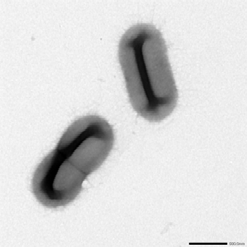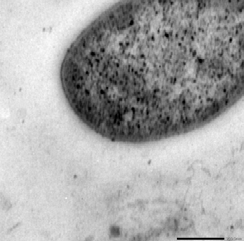Flavobacterium marinum
Flavobacterium marinum (SW105)
Ecology
The genus Flavobacterium is found in a variety of environments, including soil, fresh and saline acquatic systems, and arctic. The microbe Flavobacterium marinum was first isolated in a saltwater sample from the Indian Ocean(1). Flavobacterium are often considered opportunistic pathogens, and are responsible for a number of waterborne illnesses affecting various species of fish.
Cell Structure and Metabolism
Single Cell Morphology
Flavobacterium marinum has a gram negative, rod shaped morphology. Cells are often found in singlets or pairs, and are not capable of gliding motility, endosporulation, or capsule formation. Each cell is approximately 0.5µm in diameter and 1.5µm in length(1).
While the optimum temperature for growth is 35°C, Flavobacterium marinum is tolerant of temperatures between 15°C and 45°C. The optimal pH for growth is close to neutral conditions; however, F. marinum has been cultured between pH values of 5.5-8.5. This particular strain of Flavobacterium prefers saline environments, but is cultivable in freshwater systems(1).
Colonial Morphology
Aggregate colonies of Flavobacterium marinum appear as yellow, semiopaque structures, with a diameter measuring 1.5mm-2.0mm(1).
Metabolic Activity
F. marinum has been cultured successfully on LB (Luria-Bertani) broth, trypticase soy agar, as well as marine and nutrient agars. When tested, Flavobacterium marinum was positive for catalase and oxidase activities, negative for a variety of other metabolic tests, and was found to be incapable of reducing nitrate to nitrite(1).
Phylogeny
Flavobacterium is a genus of bacteria into which F. marinum is classified. Rod shaped, non-motile, gram negative are attributes characteristic of this genus. The phylogenetic relationship of F. marinum to others within the genus was determined by a 16S rRNA gene sequence. Coincidentally, F. marinum strain SW105 showed the most genetic congruencies with Flavobacterium ceti, and Flavobacterium ummariense(1).
Genome Structure
Little information is known about the genomic structure of F. marinum. However, the sourced paper determined that the Guanine + Cytosine composition was 36.2 mol%, which had little difference compared to the two reference strains F. ummariense at 37.4 mol% and F. ceti 36.7 mol%.(1)
References
1. Lei, Song, Liu Hongcan, et al. "Flavobacterium marinum sp. nov.." Flavobacterium marinum sp. nov., Isolated from Seawater. (2013)
Authors
Original page and amendments were created by Andrew Fischer and Torrin McDonald, both students in Prof. Ned Walker's Microbial Ecology course at Michigan State University.


